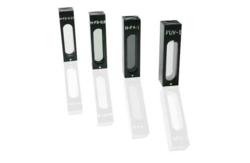Jan 6 2011
After the initial release of the nano-deposition standards in early December 2010, NSG has been seeing tremendous feedback regarding the accuracy and reliability of these UV/VIS calibration standards. Dr. Wang from University of California Riverside said, "I threw out all my old standards after using NSG's calibration kit."
Periodic verification of the performance of spectrophotometers is required by ISO 9000, GLP (Good Laboratory Practice), GMP (Good Manufacturing Practice), SOP (standard operating procedures in the pharmaceutical industry), EP, DAB, USP (pharmacopeias), and other applicable standards and regulations.
 Spectrophotometer Calibration Kit
Spectrophotometer Calibration Kit
Periodic verification of performance of spectrophotometers typically includes testing the resolution, wavelength accuracy, photometric accuracy and stray light affect.
Traditionally, the calibration of spectrophotometers has been performed with a combination of liquid filters and solid-state filters. The solid-state filters only allowed the checking of photometric accuracy and wavelength accuracy usually within the 450 nm – 630 nm range.
The liquid filters allow checking the photometric accuracy, wavelength accuracy, stray light affect, and photometric resolution usually within the 200 nm – 660 nm range.
Liquid and solid-state filters are calibrated by the filter manufacturers, and the corresponding filters performance certificates are supplied to customers.
Solid-state filters maintain their performance for many years when handled properly. However the performance of liquid filters degrades much quicker due to slow irreversible chemical reactions, photonic-promoted chemical reactions, and other reasons.
Therefore, manufacturers of liquid calibration standards require their customers to replace their liquid filters every 1 to 3 years.
Modern development of nano-technology has allowed NSG Precision Cells to develop state-of-the art solid-state quantum resonance calibration filters. The purpose of these new reference standards is to replace the old fashioned liquid based filters, such that customers can benefit from substantial savings on filter replacements and recalibrations.
Benefits of using NSG's Nano-Deposition calibration standards is obvious. No more having to replace or recalibrate your standards. They are easy to handle and are very robust due to the scratch resistant coatings. They give highly accurate and consistent calibration every time.
NSG Precision Cell's calibration standards fit into any spectrophotometer so you don't have to worry if they will work in your equipment. The nano-deposition standards are NIST traceable and can test and calibrate photometric accuracy, wavelength accuracy, photometric resolution and stray light affect.
Please refer to primary NIST calibration standards:
Photometric accuracy: SRM 930e and SRM 1930 neutral density glass filter
Wavelength accuracy: SRM 2034 Holmium oxide solution
Wavelength accuracy is achieved through calibrating the peaks of several wavelengths in the UV, visible, and (where applicable) IR spectra. Traditionally, the Holmium Oxide and Didymium glass filters offer weaker peaks in comparison to the holmium oxide-liquid filters. A similar effect can be observed with the Didymium glass filters.
NSG's proprietary nano-deposition and nano-embedded technology overcomes the disadvantages of using solid-state filters making them better than the current liquid-based filters. Moreover, the number of peaks for calibration produced by NSG's composite medium is quantum-harmonics' based and therefore, the quality of achieved calibration of spectrophotometers is assured by fundamental principals of physics of harmonic wavelength relations. This method is by far superior to asymmetric wavelength peaks produced by a liquid medium.
Based on the positive feedback, NSG Precision Cells says that they expect to see a lot more scientists switching over to these new nano-deposition UV/VIS standards in early 2011.
Source: http://www.precisioncells.com/